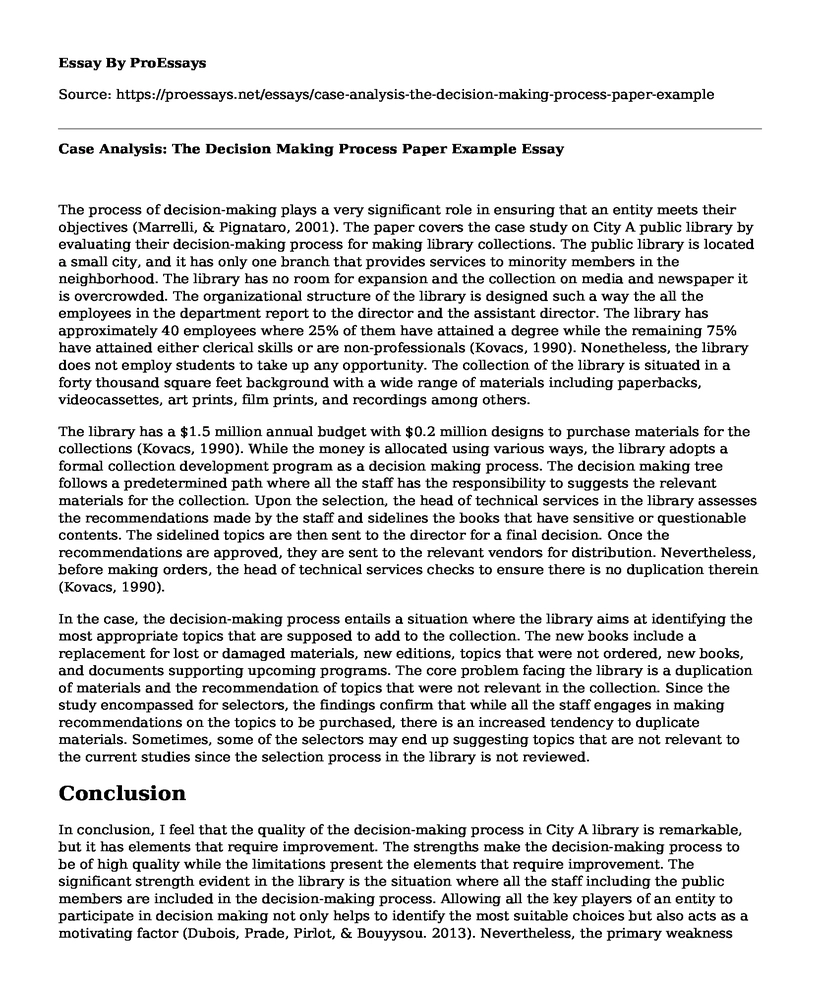The process of decision-making plays a very significant role in ensuring that an entity meets their objectives (Marrelli, & Pignataro, 2001). The paper covers the case study on City A public library by evaluating their decision-making process for making library collections. The public library is located a small city, and it has only one branch that provides services to minority members in the neighborhood. The library has no room for expansion and the collection on media and newspaper it is overcrowded. The organizational structure of the library is designed such a way the all the employees in the department report to the director and the assistant director. The library has approximately 40 employees where 25% of them have attained a degree while the remaining 75% have attained either clerical skills or are non-professionals (Kovacs, 1990). Nonetheless, the library does not employ students to take up any opportunity. The collection of the library is situated in a forty thousand square feet background with a wide range of materials including paperbacks, videocassettes, art prints, film prints, and recordings among others.
The library has a $1.5 million annual budget with $0.2 million designs to purchase materials for the collections (Kovacs, 1990). While the money is allocated using various ways, the library adopts a formal collection development program as a decision making process. The decision making tree follows a predetermined path where all the staff has the responsibility to suggests the relevant materials for the collection. Upon the selection, the head of technical services in the library assesses the recommendations made by the staff and sidelines the books that have sensitive or questionable contents. The sidelined topics are then sent to the director for a final decision. Once the recommendations are approved, they are sent to the relevant vendors for distribution. Nevertheless, before making orders, the head of technical services checks to ensure there is no duplication therein (Kovacs, 1990).
In the case, the decision-making process entails a situation where the library aims at identifying the most appropriate topics that are supposed to add to the collection. The new books include a replacement for lost or damaged materials, new editions, topics that were not ordered, new books, and documents supporting upcoming programs. The core problem facing the library is a duplication of materials and the recommendation of topics that were not relevant in the collection. Since the study encompassed for selectors, the findings confirm that while all the staff engages in making recommendations on the topics to be purchased, there is an increased tendency to duplicate materials. Sometimes, some of the selectors may end up suggesting topics that are not relevant to the current studies since the selection process in the library is not reviewed.
Conclusion
In conclusion, I feel that the quality of the decision-making process in City A library is remarkable, but it has elements that require improvement. The strengths make the decision-making process to be of high quality while the limitations present the elements that require improvement. The significant strength evident in the library is the situation where all the staff including the public members are included in the decision-making process. Allowing all the key players of an entity to participate in decision making not only helps to identify the most suitable choices but also acts as a motivating factor (Dubois, Prade, Pirlot, & Bouyysou. 2013). Nevertheless, the primary weakness evident is that the directors do not value the aspect of evaluating the recommendations made the staff and other selectors as they find it is labor intensive. Therefore, it is essential to evaluate the process to monitor the success of the choices as a way to ensure that the best materials are purchased for the collection.
References
Dubois, D., Prade, H., Pirlot, M., & Bouyysou. (2013). Decision making process: concepts and methods. New York, NY: John Wiley & Sons.
Kovacs, B. (1990). The decision-making process for library collections: Case studies in four types of libraries. New York: Greenwood Press.
Marrelli, M., & Pignataro, G. (2001). Public decision-making processes and asymmetry of information. Boston, MA: Springer US.
Cite this page
Case Analysis: The Decision Making Process Paper Example. (2022, Aug 15). Retrieved from https://proessays.net/essays/case-analysis-the-decision-making-process-paper-example
If you are the original author of this essay and no longer wish to have it published on the ProEssays website, please click below to request its removal:
- Essay Example on Lieutenant Colonel Adam and His Leadership Style
- Adversarial Relationships: How to Create Better Relationships
- Fitbit VRIO Analysis Paper Example
- Message to the Management - Essay Sample
- Essay on Contingency Theory: No One-Size-Fits-All Leadership and Decision-Making
- Essay on SmartTech Consultants: 5-Year Strategic Plan for Up-Scaling & Quality Service
- Essay Sample on Project Cost Overruns







